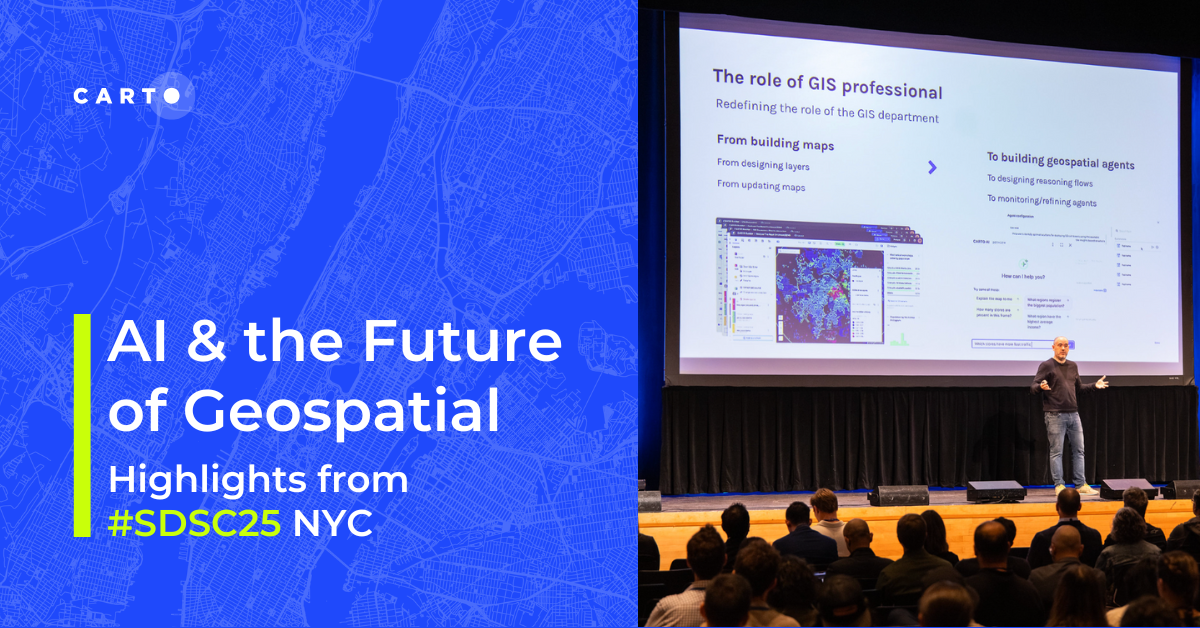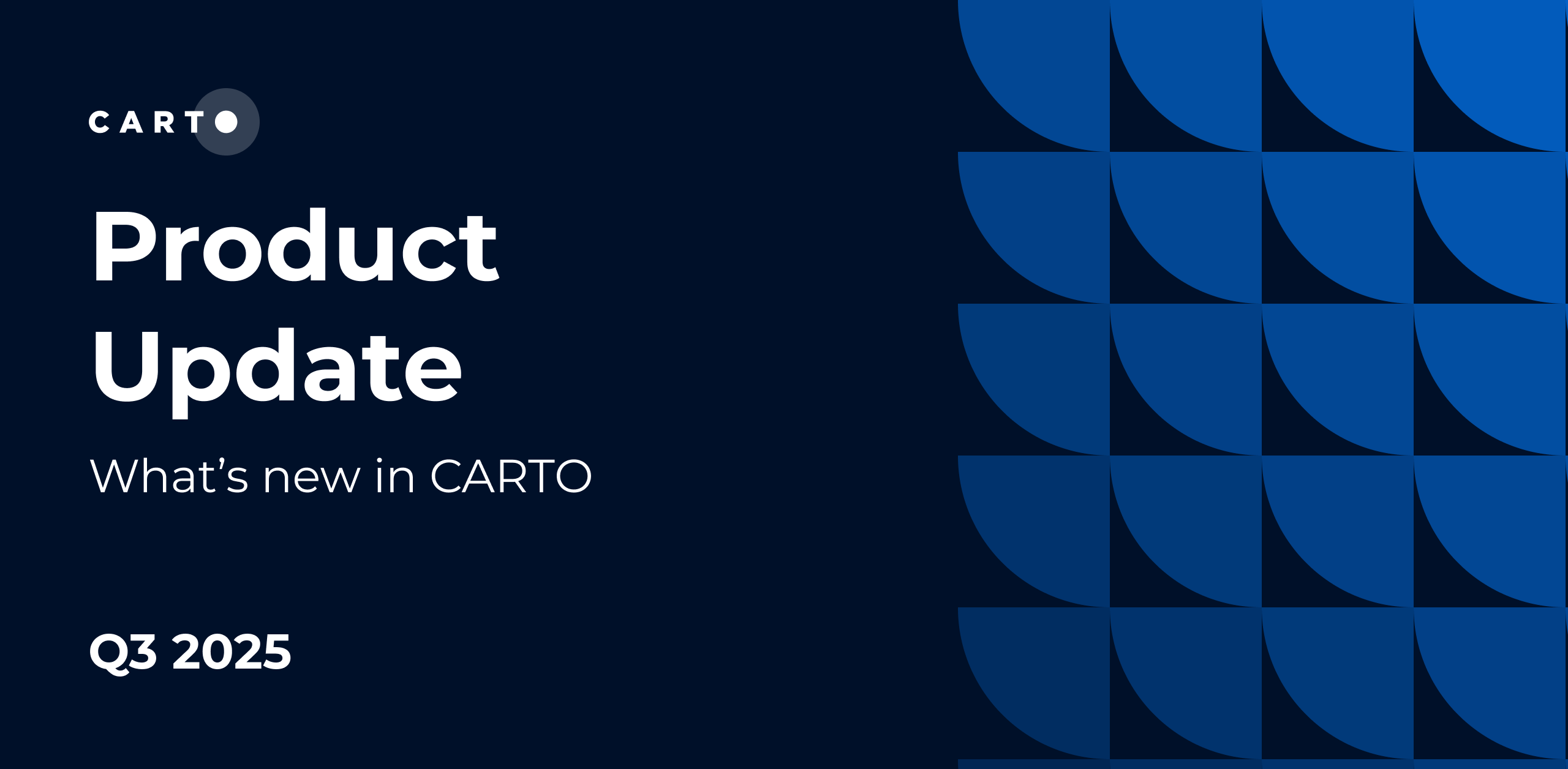What's New in CARTO - Q1 2025

As we stride into 2025, CARTO has kicked off the year with an array of exciting new features that bring unique functionalities for cloud-native spatial analytics at scale.
Our commitment is to push the boundaries of spatial analysis and visualization on top of the leading cloud platforms. Allowing our users to break the GIS data silo, by empowering them with an AI-powered platform for turning spatial data into real outcomes - without having to compromise in security and data governance.
In Q1 2025, we have expanded our platform with full capabilities to analyze and visualize raster data from your lakehouse. Other updates include a QGIS plugin for editing cloud-hosted data, our new AI Agents for easily extracting geospatial insights from maps, enhanced ways of securely connecting with your lakehouse, and much more. Let’s dive in!
Want to try some of these great new features? You can sign up for a free 14-day CARTO trial here, or request a demo from one of our experts to learn how you can leverage them to take your spatial analysis to the next level!
Helps you to: Work seamlessly with raster data in your lakehouse, simplifying workflows and maintaining full data governance.
CARTO now supports raster visualization in Builder, allowing you to seamlessly integrate and analyze raster datasets at a massive scale. This eliminates the need for external tools, streamlining workflows and reducing costs while maintaining data governance - all inside your lakehouse.
By enabling native raster support, CARTO brings unmatched scalability and flexibility to spatial analytics. This integration simplifies your workflows, cuts down on data duplication and conversion, and provides a unified environment for both raster and vector data analysis, empowering you to unlock deeper insights with ease. Learn more in this blog.
Helps you to: Improve performance and streamline the visualization of shared geometries.
Working with datasets where multiple rows share the same geometry? Builder now supports aggregating those features in layer visualizations. This improves performance for visualizing data where this problem is common - such as with administrative boundaries or infrastructure locations - while maintaining access to detailed insights.
Helps you to: Streamline spatial data analysis by directly connecting QGIS with CARTO for more seamless data editing.
As geospatial data grows bigger, faster, and more complex, traditional desktop GIS tools struggle with scalability, integration, and performance. However, they remain crucial for completing specific geospatial tasks which are difficult to accomplish in a cloud environment - such as editing and creating geometry data.
Enter the CARTO QGIS plugin! With this plugin, you can seamlessly access and edit your cloud-hosted geospatial data, all within QGIS! Users can now leverage CARTO’s scalable analytics and cloud data warehouses while continuing to use QGIS for essential GIS functions like geometry editing and static map creation.
Want to see it in action? Learn more in this blog.
Helps you to: Share maps securely with more granular control.
CARTO now allows you to share your maps with specific users, giving you greater control over data access and collaboration. In addition to making maps private, public or restricting them to an entire organization, you can now grant access to individual users, ensuring that the right people see the right insights. This makes it far easier to share location intelligence with key stakeholders while maintaining governance over sensitive information.

Helps you to: Make spatial analysis instant and more accessible with natural language queries.
Spatial analysis just got smarter and more accessible with CARTO AI Agents, now available in public preview! This AI-powered tool allows users to interact with maps using natural language, making geospatial insights available to anyone - no GIS expertise required.
With CARTO AI Agents, users can:
- Eliminate bottlenecks by enabling self-service spatial analysis
- Accelerate decision-making with instant, AI-generated insights
- Enhance accessibility by making geospatial data more intuitive and actionable
By simply asking questions, users can dynamically explore location data, adjust parameters, and uncover trends without writing SQL or running complex workflows. Organizations like Clear Channel and Aramex are already using AI Agents to optimize operations and streamline decision-making - learn how in our blog!
Helps you to: Automate tasks and improve workflow consistency by creating and sharing custom, reusable components.
CARTO Workflows just got more powerful and customizable with the introduction of Workflows Extension Packages! Now, users can extend, automate, and share their geospatial analytics by creating and integrating custom components within CARTO Workflows.
With Workflows Extension Packages, you can create package, and distribute your own SQL-based custom components - or use one of the ones we’ve created:
- Google Earth Engine & Environment API Integration – incorporate global environmental datasets into your geospatial workflows and leverage real-time data on solar energy, air quality, and pollen forecasts.
- Telco Signal Propagation Models – Optimize network planning with industry-specific signal modeling tools.
- BigQuery ML – Build and deploy machine learning models directly within Google BigQuery.
- Snowflake ML – seamlessly build, train, and deploy ML models - all easily inside your Snowflake environment.
Helps you to: Integrate location data and enrich your analysis within Databricks, all running natively in your platform.
CARTO now supports Location Data Services (LDS) and Data Enrichment on Databricks, allowing users to seamlessly enrich their datasets with geospatial data like demographics, points of interest, and more directly within their Databricks notebooks. Additionally, users can now perform geocoding, routing and isoline calculations on their Databricks accounts. With this feature, users can perform powerful geospatial queries and gain deeper insights within a unified platform.
Helps you to: streamline managing your spatial resources by automating processes and ensure efficient process scaling.
Our new Resources API allows you to automate and scale the management of your spatial resources seamlessly. Whether you're handling large volumes of maps, workflows, or connections, this API provides a centralized way to manage and track them. By leveraging the API, you can streamline operations, reduce manual interventions, and ensure that your workflows run smoothly even as your projects grow in complexity.

Helps you to: enable more secure, seamless, compliant data access and management.
CARTO now supports Workload Identity Federation to connect seamlessly with Google BigQuery, simplifying data integration and enabling secure access to your BigQuery datasets from within the CARTO platform. This feature enhances data analysis by providing smooth interoperability while maintaining strong security controls.
With Workload Identity Federation, you can set up a trust relationship between CARTO and your Google Cloud projects for a smooth integration — In other words, you will be managing permissions to each of your CARTO users directly in Google Cloud, using IAM rules.

Helps you to: Establish secure, encrypted connections, ensuring safe data transfers.
Snowflake users can now leverage Key-pair authentication for their Snowflake integration, enabling a secure and efficient connection between the two platforms. This is a more secure alternative to basic username/password authentication, as it is highly resistant to brute-force attacks, eliminates password management complexities, and can be easily used as the authentication mechanism for scripts and applications. We've also added support for Key-pair rotation, enabling users to update the private key of Key-pair connections they own. For more information, see our section on Key-pair authentication for Snowflake connections.

Helps you to: Simplify and secure your integration between CARTO and Databricks, streamlining access to your spatial data.
Users can now connect to their Databricks account using OAuth authentication, with both Machine-to-Machine (M2M) and User-to-Machine (U2M) authentication flows supported. This allows a more secure and seamless integration between the two platforms. With OAuth, users can easily authenticate and access their Databricks data within CARTO for spatial analysis without needing to manage multiple credentials.

—
That’s a wrap on our product updates from Q1 2025 - we hope you enjoy using them to take your spatial analysis to the next level! To stay up to date on our most recent product releases remember to keep an eye on our What’s New page and follow us on LinkedIn for as-they-happen announcements, or get these delivered straight to your inbox with our monthly CARTO newsletter!
Looking for resources to help you on your spatial journey? As always, our Academy is here to help you deepen your expertise, or you can request a demo with one of our experts here.














.png)

